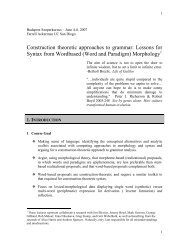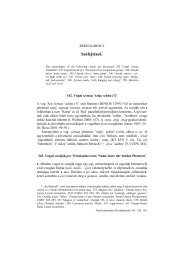Nyelvtudományi közlemények 91. kötet (1990)
Nyelvtudományi közlemények 91. kötet (1990)
Nyelvtudományi közlemények 91. kötet (1990)
Sie wollen auch ein ePaper? Erhöhen Sie die Reichweite Ihrer Titel.
YUMPU macht aus Druck-PDFs automatisch weboptimierte ePaper, die Google liebt.
74 TAMÁS HOFFMANN<br />
an attic and separated off. This new area was not heated by an open fire,<br />
but by a tiled oven, the stove. The stove was heated from another room. The<br />
essence of this innovation lies in the fact that combustion products don't<br />
pollute the air of the room any longer. Surely, in the beginning, this solution<br />
worked well in the bath-houses, and the advantages experienced were flrst<br />
applied to Castles, manor-houses and the houses of townsfolk. Finally, as<br />
it usually happens, the more comfortable living standard found its way to<br />
the house of peasants as well. This innovation spread from Northern Italy<br />
to the north. In the Castles and manors of thirteenth Century England the<br />
first chimneys were built, and somewhat later stove-heated rooms as well.<br />
In the Alpine zone the habitability of peasant houses was increased by the<br />
stove only by the end of the Middle Ages, and even then only sporadically.<br />
But even where rooms were built, people didn't always want to better their<br />
living circumstances, and every-day circumstances. On the contrary: a main<br />
reason for building was prestige.<br />
In régions of Southern Germany, where by the end of the period well-todo<br />
peasants built houses with rooms other then the kitchen; this was needed<br />
to assure a représentative area. In this représentative room the table, sometimes<br />
reaching a height of one meter, an armchair and at least two benches<br />
aside the table, ail had their place. The armchair and table were séries<br />
products of the end of the period, and the carpenter himself could thank<br />
his specialization to this cuit ural need. Materially, the sawmill provided<br />
the preconditions for the work of the carpenters, since semiprocessed goods<br />
stepped into the place of carpentry techniques used previously. The room,<br />
furnished according to dining demands stemming from the dining rooms of<br />
townsfolk and nobles, is a différent world within the peasant-house. This<br />
room was not used for cooking, nor did anyone sleep in it. In other words,<br />
life functions separated from each other where the house had a room such<br />
as this. Actually, this was the most important innovation which changed<br />
the life conditions of the Middle Ages. Yet we must add, that this happened<br />
with limited validity, and on small patches of the continent, about one-tenth<br />
of ail of Europe.<br />
At the same time another innovation appeared around the peasanthouse,<br />
the two-storied granary. Earliest examples of this type can be found<br />
in areas where besides there was a separate room, and where the house<br />
was built together with the stalls and haylofts. Originally the granary was<br />
a separate building in ail areas of Europe where, because of high ground<br />
water, the harvested crops could not be stored in pits in the ground, such<br />
as in the end north of the Alps up the Scandinavia, an the Russian Plains.<br />
The building of granaries was customary as far back as the Bronze Age.<br />
The innovation of the Middle Ages was it's increased capacity, which was put<br />
into practice herein. The architecture of the two-story granary stems from<br />
Nyelvtudományi Közlemények <strong>91.</strong> <strong>1990</strong>.


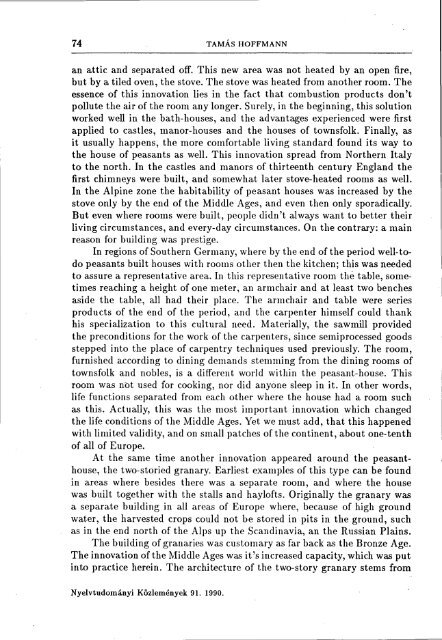





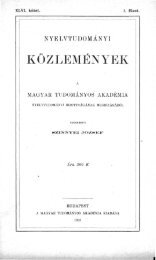
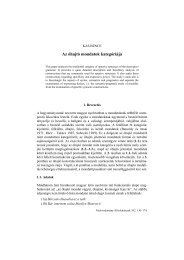
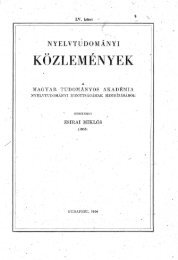
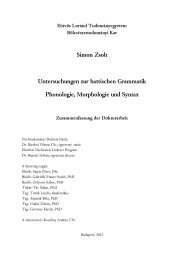
![Gósy Mária: A [p, t, k] mássalhangzók zöngekezdési ideje Bevezetés ...](https://img.yumpu.com/15682849/1/190x245/gosy-maria-a-p-t-k-massalhangzok-zongekezdesi-ideje-bevezetes-.jpg?quality=85)

